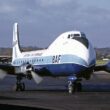Mark Swan, Head of the Airspace Change Organizing Group (ACOG), had just started a new role when Covid struck. In this article, Swan shares how he dealt with the invisible crisis.
I had recently started a new role as Head of the UKs Airspace Change team when Covid struck. Prior to that, I had 30 years’ experience as an operational military pilot and ten years as the airspace and safety director in the UK Civil Aviation Authority. So I thought I could plan successful large scale campaigns and help manage the country out of crises, ranging from erupting volcanoes in Iceland to the sadly tragic, but not frequent, aviation accidents that required decisive action nationally and internationally to keep aviation airborne and people safe. With Covid it was different; an invisible and devastating enemy with no rules of engagement, no humanity, and on such a global scale, impossible to envisage a strategy or make a plan.
Why? Because although it destroyed aviation and stopped us in our tracks, the frontline became the war bands of health workers and scientists who have worked tirelessly to save their respective nations as a global coalition that militaries the world over could only ever dream of. Many too have made the ultimate sacrifice in that endeavour for which there are no campaign medals only everlasting gratitude. Their challenge could not be assisted by the traditional methods used to counter risks and keep people safe. All of the tools and techniques, policies and regulations refined and handed down over the ages from government to government, agency to agency, person to person simply did not work. This is a microbiological war that has left the rest of us feeling helpless and inadequate in spite of the lifetime of credentials and experience we thought we had, that would keep aviation airborne and people safe!

Mark Swan, Head of ACOG
So what did our team do? The first thing we did was try not to help, recognising that we could not and so we kept our heads down and let those who needed to manage, manage. Both in our own sector and more widely – perhaps the hardest thing to do; stay out of it until asked. We looked after each other by meeting virtually three days a week and formed a self-supporting bubble to preserve health and morale. As things began to become clearer, we then started to scenario plan, to provide a path, a selection of options that might help get the sector back to a brighter future albeit a distant one. We focused on making the return of aviation to the skies a better environment, literally and have planned for a more environmentally sustainable future.
Our future programme of transformational airspace design with its focus on quicker quieter and cleaner journeys will provide our sector with the ability to literally build back better, this time using our collective expertise to manage that invisible intangible that is airspace, where we are expert and can make a difference. We are looking forward to getting started.









